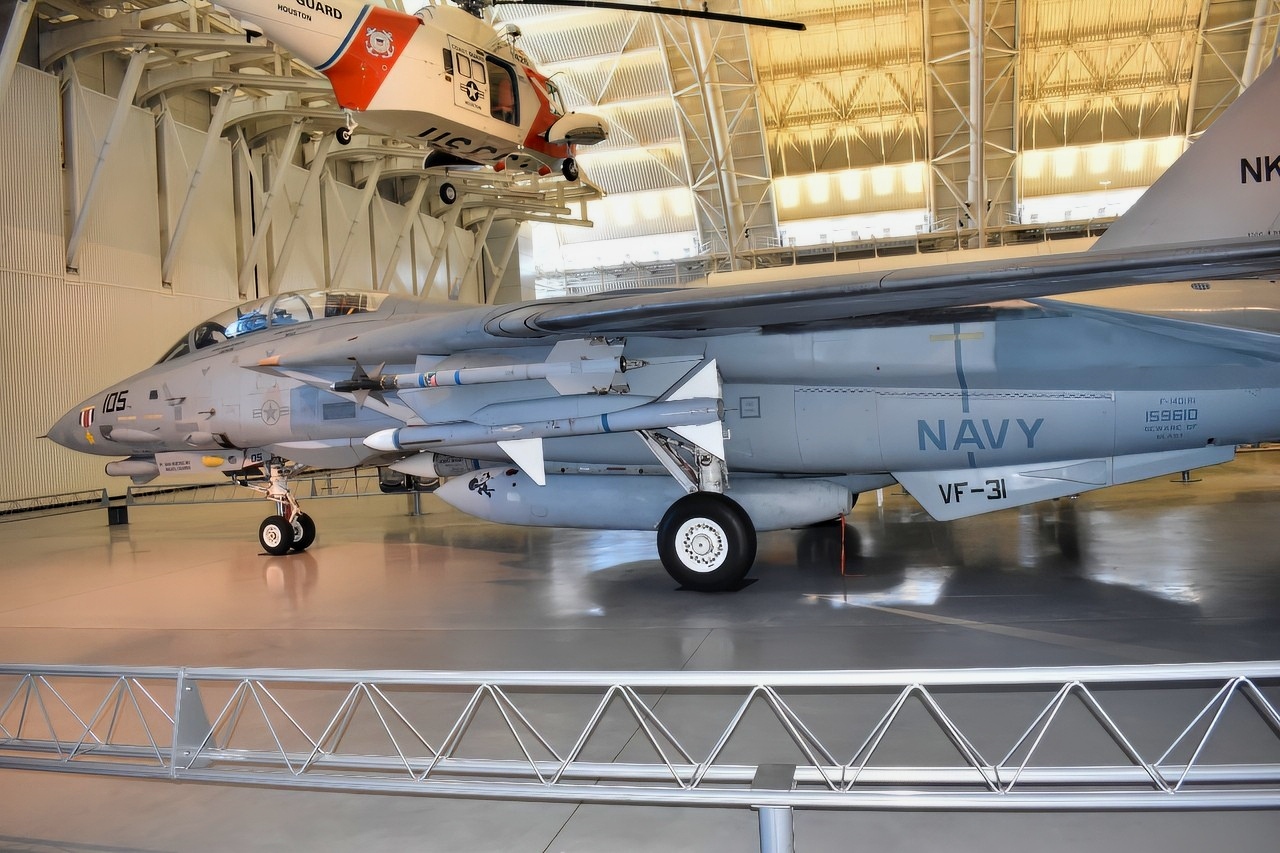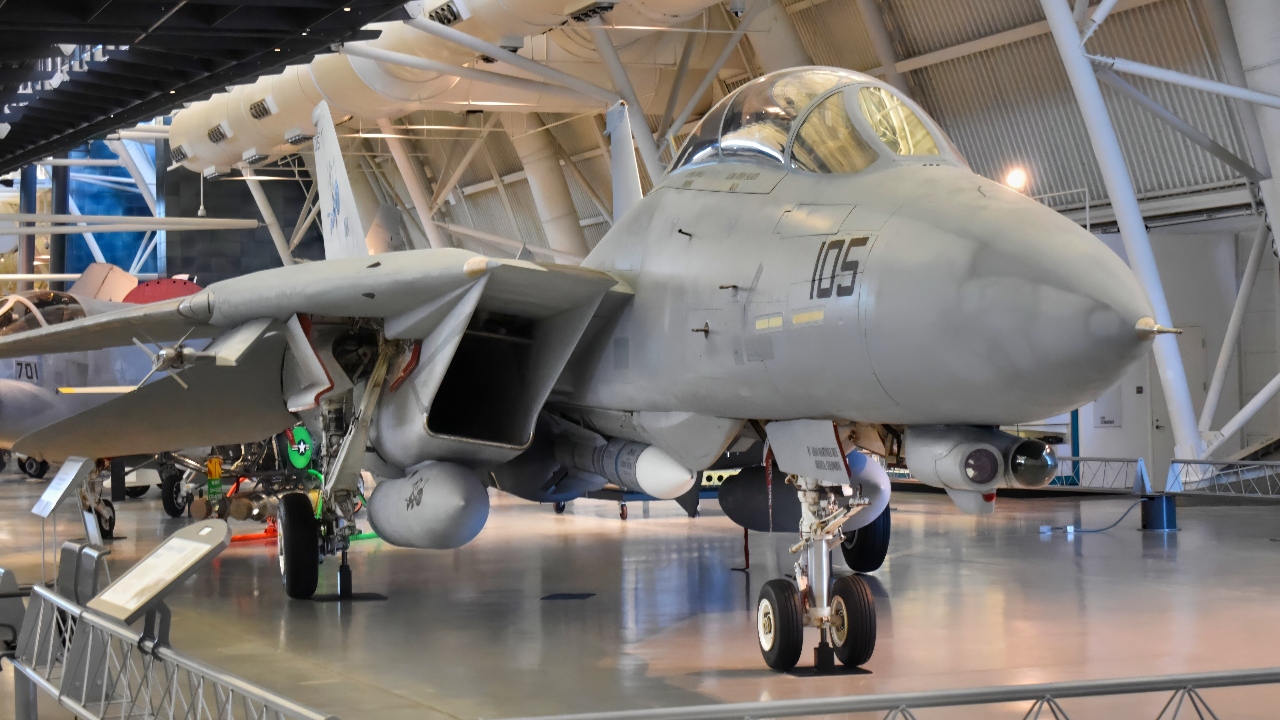Key Points and Summary – Navy veterans of the F-14 Tomcat recall why the jet still inspires: variable-sweep wings, big fuel and big missiles, and lessons earned the hard way.
-Former Topgun instructor Capt. Sam “Slammer” Richardson describes mastering the jet’s quirks—especially early TF30 engines—and beating a Luftwaffe MiG-29 by out-thinking the pilot, not the airplane. RIO Joe “Smokin”

F-14 Tomcat at Steven F. Udvar-Hazy Center. Image by Brent M. Eastwood for National Security Journal.
-Ruzicka recounts a night shoot where twin AIM-54 Phoenixes obliterated a drone—“Boola Boola”—showing the Tomcat’s reach.
-The piece captures tactics, technology and culture from cockpit to carrier, explaining why pilots and RIOs still speak of the F-14 with grin-inducing respect.
F-14 Tomcat Pilot and RIO Remember the Airplane Fondly
We know you just love the F-14 Tomcat, and you can’t get enough of our coverage of one of the most famous fighter jets of all time. This is for good reason. The warbird stands out from the crowd because of its great looks, performance, and combat record spanning roughly 37 years.
We’d like to share insights from an F-14 Tomcat pilot and former Top Gun instructor, offering a firsthand look at what it takes to defeat an adversary in the air.
The Phoenix Rises
The Tomcat was known for dogfighting and ground strike capability. It deployed a long-range beyond visual range missile called the AIM-54 Phoenix that could blast enemy aircraft from 90 miles away. This capability was a considerable advantage during aerial combat. The Phoenix missile could reach out and touch the enemy without the adversary ever knowing what hit him.
What Else Made the F-14 Great?
The F-14 also had variable sweep wings that enabled high-speed maneuvers, giving the Tomcat a significant advantage in engagements, big and small. This thrust also allowed the Tomcat to accelerate and climb with a heavy weapons payload.
Our friends at AviationGeekClub.com unearthed an intriguing interview with an F-14 aviator who appeared on a podcast in 2021. Retired US Navy Captain Sam “Slammer” Richardson recalled the days onboard the F-14 with gusto. His interview was broadcast by the “F-14 Tom-cast”—a program devoted to all things related to the popular airplane.
Slammer Tells His Story
Richardson was originally assigned to fly the F-14 full-time after flight school. However, since there were no Tomcats available for the new naval aviator, the Navy sent Slammer to be a temporary instructor. There, he became more experienced while teaching. He began to push the F-14 beyond the parameters of his original training.
Richardson learned how to use more rudder to conduct a roll when flying at low speeds. He was educated about the pros and cons of the F-14. He also acquired knowledge on how to conserve fuel most effectively during missions.
The Early Engines Were Not Sufficient
Slammer concluded that it was easy to learn to fly the F-14, but it was much more difficult to fly it well. Richardson was forced to deal with operating earlier Tomcat engines that had their drawbacks, and most aviators began to loathe the Pratt & Whitney TF30 engines. “Those weren’t good engines. You had to fly the engines,” Slammer said.
F-14 vs. MiG-29
Despite this disadvantage, Slammer loved flying the F-14. He recalled one engagement that stuck in his mind and reminded him of how well the Tomcat performed in combat, real and simulated.
In the late 1990s, when Slammer was flying for the “Tophatter” VFA-14 squadron, he went up one-on-one with a German air force MiG-29 Fulcrum for dogfighting practice. In the first iteration, the MiG-29 got the best of Slammer and scored one win for the Luftwaffe.
Slammer knew he needed an extra surge of adrenaline to find a solution and win the next simulated battle. He said, “I’m scramblin’ through my mind. What do I gotta do? I realized I can’t fight the airplane, I gotta fight the pilot.”
Richardson quickly figured out the solution. “I intentionally flew directly under him. I knew he was aggressive as hell, and sure enough, he bit. I saw his two afterburners. He is probably doing 500 knots, straight downhill, with both afterburners. And I thought, ‘Gotcha!’ I came up over the top, repositioned my nose, and I’m looking at an arcing MiG-29.”
This strategy led to Slammer winning the “fight.” He recalled the engagement well and was delighted to know the gun camera captured video.
“It’s very impressive to see gun camera with a MiG in the reticle.” He had forced the MiG-29 pilot to radio the words “Knock it off.”
After that, the German pilot talked incessantly about how good the F-14 and its pilot reacted during the notional dogfight.
More About the Phoenix Missile
That was a short-range engagement, but the F-14 had an ace card up its sleeve. I mentioned the AIM-54 Phoenix before. This weapon allowed the F-14 to make long-range shots against the enemy.
Lt. Commander Joe “Smokin” Ruzicka, the Radar Intercept Officer on board the F-14, explained to Jalopnik.com how the Tomcat could hit paydirt using Phoenix missiles. In this interview, you can learn what it means when the Phoenix achieved “Boola Boola.”
“Our squadron did a night AIM-54 Phoenix shoot where we shot two Phoenixes at range against a drone. The shots were staggered by about 2 miles, one right after the other. Our lead safes, while on NVG’s, followed both missiles toward the target. They reported back that the first Phoenix was ‘Boola Boola,’ meaning a direct hit and completely destroying the drone. They said what happened next was pretty amazing. The second Phoenix quickly made an adjustment off what was left of the drone and hit the largest remaining part. Remember, this 1,000lb missile is traveling at Mach 3.0 and only a couple of miles behind the first missile, so there was very little time for the missile to react. I guess the ‘Ordies’ had programmed it for ‘pulverization mode.’”
We Got Close to an F-14D Tomcat Just Last Week
The Tomcat was one versatile airplane that we love discussing. For more, check out how we recently visited a museum exhibition and conducted our own interview with an F-14 pilot.

F-14 Tomcat Fighter National Security Journal Photo
The aviators and their back-seat RIOs still have great memories when they were onboard the Tomcat, and we’ll continue to keep their words alive here on the pages of National Security Journal.
About the Author: Brent M. Eastwood
Brent M. Eastwood, PhD is the author of Don’t Turn Your Back On the World: a Conservative Foreign Policy and Humans, Machines, and Data: Future Trends in Warfare plus two other books. Brent was the founder and CEO of a tech firm that predicted world events using artificial intelligence. He served as a legislative fellow for US Senator Tim Scott and advised the senator on defense and foreign policy issues. He has taught at American University, George Washington University, and George Mason University. Brent is a former US Army Infantry officer. He can be followed on X @BMEastwood.
More Military
The Eurofighter Might Be Able to Beat the F-35
Seawolf-Class: The Best Submarine Ever?
The Royal Navy Has a Destroyer Stuck in Port for 3,000 Days










